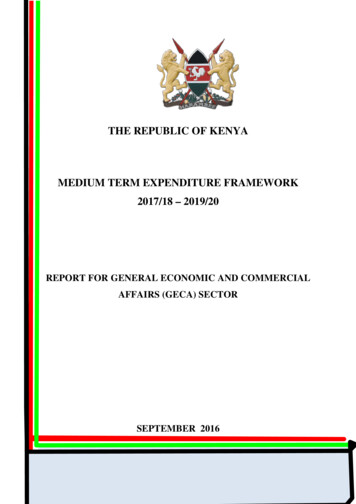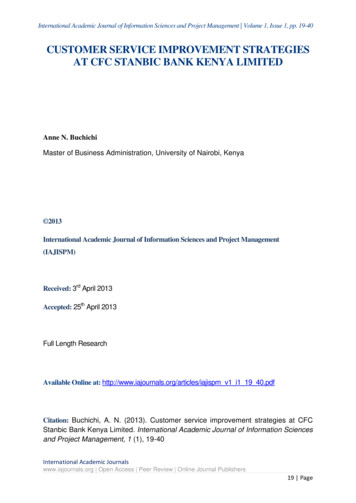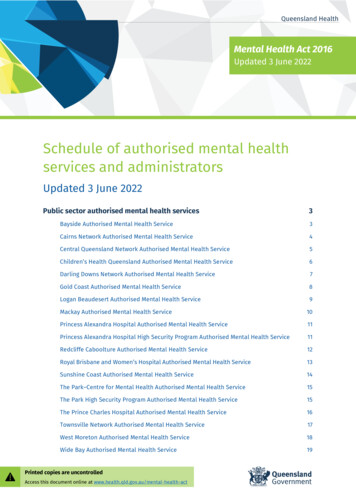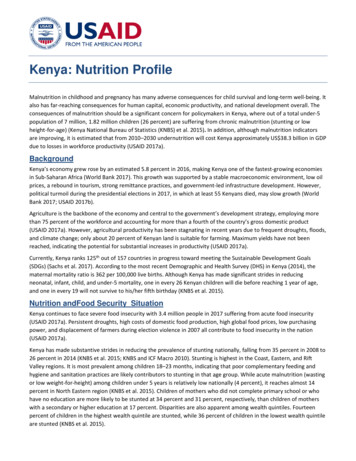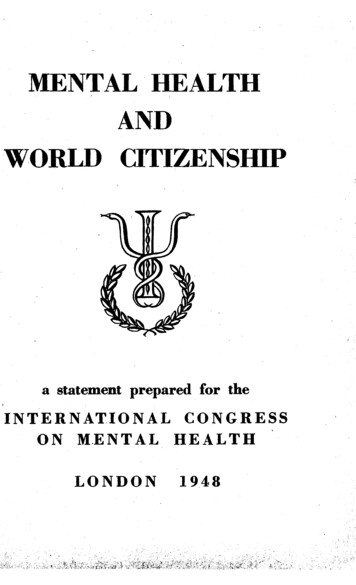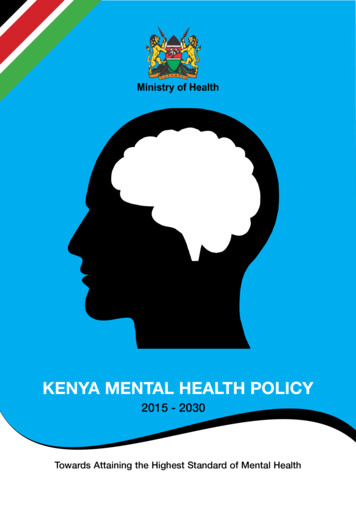
Transcription
KENYA MENTAL HEALTH POLICY2015 - 2030Towards Attaining the Highest Standard of Mental Health
Nairobi, August 2015Any part of this document may be freely reviewed, quoted,reproduced or translated in full or in part, provided the sourceis acknowledged. It may not be sold or used for commercialpurposes.Kenya Mental Health Policy 2015–2030Published by:Ministry of HealthAfya House, Cathedral RoadPO Box 30016 Nairobi 00100http://www.health.go.keEdited by Dr David E Bukusi
CONTENTSPART 1: BACKGROUND .11.1Introduction.11.2Understanding Mental Health .11.3Mental Health and Mental Disorders: Determinants andConsequences.21.4Policy Rationale .21.5Policy Development Methodology .31.6Situational Analysis.31.6.1 Burden and prevalence of mental disorders:The Global Context .31.6.2 Burden and prevalence of mental disorders:The Kenyan Context .4PART 2: MENTAL HEALTH POLICY FRAMEWORK.62.1Guiding Principles.62.2Vision, Goals, Objectives and Strategies.72.3Policy Directions.82.3.1 Mental Health Leadership and Governance .82.3.2 Human Resources.92.3.3 Financial Resources.102.3.4 Mental Health and Substance Use.112.3.5 Mental health services.122.3.6 Health Products and Technologies.152.3.7 Mental Health Information System (MHIS) and Research.152.3.8 Infrastructure .162.3.9 Advocacy and Partnership.172.3.10 Mental Health and Vulnerable Groups:.182.3.11 Mental Health and socio-cultural perspective .19PART 3: IMPLEMENTATION FRAMEWORK.203.1Management and coordination of the policy framework.203.2Roles and responsibilities .20PART 4: MONITORING AND EVALUATION OF POLICY.24
FOREWORDThe Kenya Health Policy, 2014 – 2030 gives directions to ensure significant reduction in theoverall ill health in Kenya in line with the country’s Vision 2030 and the Kenya Constitution,2010. This is a sector commitment under government stewardship in ensuring theCountry attains the highest possible standards of health, in a manner responsive to thepopulation needs. It focuses on ensuring equity, people centeredness and participatoryapproach, efficiency, multi-sectoral approach and social accountability in delivery of healthcare services. The Kenya Mental Health Policy 2015-2030 provides for a framework oninterventions for securing mental health systems reforms in Kenya.This is in line with the Constitution of Kenya 2010, Vision 2030, the Kenya Health Policy(2014-2030) and the global commitments. The Constitution of Kenya 2010, in article 43.(1a) provides that “every person has the right to the highest attainable standard of health,which includes the right to healthcare services”. This includes mental health. This policyseeks to address the systemic challenges, emerging trends and mitigate the burden ofmental health problems and disorders.The Kenya Mental Health Policy 2015-2030 is a commitment to pursuing policy measuresand strategies for achieving optimal health status and capacity of each individual. The goalof this policy is attainment of the highest standard of mental health. This policy recognizesthat it is the responsibility of every person in the public and private sector to ensure thegoal is attained. Mental health policy interventions are broad and cut across other sectors,and consequently, this calls for a multi-disciplinary and inter-sectoral approach in theimplementation of this policy. This policy was developed through a consultative processinvolving the public, private and non-state actors under the stewardship of the Ministry ofHealth.This policy highlights why mental health should be understood; Mental health is a keydeterminant of overall health and socio-economic development. It influences individualand community outcomes such as healthier lifestyles, better physical health, improvedrecovery from illness, fewer limitations in daily living, higher education attainment, greaterproductivity, employment and earnings, better relationships with adults and with children,more social cohesion and engagement and improved quality of life. This policy also bringsout the determinants of mental health and mental disorders, the burden and prevalenceof mental disorders globally and locally and the challenges facing mental health care andservice delivery in Kenya. It also provides policy directions on prevention, management andcontrol of mental disorders.It is therefore my belief that collectively we can make a difference. Let us all join hands inembracing healthy lifestyles towards achieving a mentally healthy society.Mr. James MachariaCabinet SecretaryMinistry of Health
ACKNOWLEDGEMENTSThe Kenya mental Health Policy 2015 – 2030 exercise was accomplished through theconcerted efforts of many organizations, institutions, Stakeholders and individuals, whoassisted in a variety of ways towards its preparation, editing and publication.Foremost, I acknowledge the mental health unit, under the Division of Clinical Practice(Ministry of Health) and the technical working group, who spearheaded the whole exercise.Special acknowledgement goes to the World Health Organization (WHO) who providedboth technical and financial support for the documents planning, developing, editing,publication and also contributed support towards the official launch of this National MentalHealth Policy.Last but not least, acknowledgement also goes to all the non-governmental organizationswho stood with the ministry to see to it that this document comes to pass and that thepolicy will be utilized by all stakeholders to provide a road map to the provision of qualitymental health services as envisaged in the Kenya constitution 2010, Kenya vision 2030 andin line with international Health legislations.
ABBREVIATIONSCBOCommunity Based OrganizationDALYsDisability- Adjusted Life YearsFBOFaith Based OrganizationHISHealth Information SystemICTInformation and Communication TechnologyKNCHR Kenya National Commission on Human RightsMHAMental Health Act (1989)MHISMental Health Information SystemMNSMental, Neurological and Substance useNGONon-Governmental OrganizationPPPPublic-Private-PartnershipWHOWorld Health Organization
PART 1:BACKGROUND1.1 IntroductionThe Kenya Mental Health Policy 2015-2030 provides for a framework oninterventions for securing mental health systems reforms in Kenya. This is in linewith the Constitution of Kenya 2010, Vision 2030, the Kenya Health Policy (20142030) and the global commitments. The Constitution of Kenya 2010, in article 43.(1)(a) provides that “every person has the right to the highest attainable standard ofhealth, which includes the right to healthcare services” 1. This necessarily includesmental health. The 65th World Health Assembly adopted Resolution WHA65.4 onthe global burden of mental disorders and the need for a comprehensive coordinatedresponse from the health and social sectors at country level. Subsequently, duringthe 66th World Health Assembly, Resolution WHA66.8 was adopted. It called onmember states to develop comprehensive mental health action plans in line withthe Global Comprehensive Mental Health Action Plan 2013-2020.1.2 Understanding Mental HealthThe World Health Organization (WHO) in its constitution of 1948 defines healthas “a state of complete physical, mental and social well-being and not merely theabsence of disease or infirmity”2.Mental health is defined as “a state of well-being whereby individuals recognizeand realize their abilities, are able to cope with the normal stresses of life, workproductively and fruitfully, and make a contribution to their communities”3 (WHO:2003). Positive mental health includes emotion, cognition, and social functioningand coherence. (WHO: 2009).Mental health is a key determinant of overall health and socio-economicdevelopment. It influences a variety of outcomes for individuals and communitiessuch as healthier lifestyles; better physical health; improved recovery from illness;fewer limitations in daily living; higher education attainment; greater productivity,employment and earnings; better relationships with adults and with children; moresocial cohesion and engagement and improved quality of life (WHO: 2009).1 The constitution of Kenya 20102 http://www.who.int/about/definition/en/print.html (Preamble to the Constitution of the WorldHealth Organization as adopted by the International Health Conference, New York, 19-22 June,1946; signed on 22 July 1946 by the representatives of 61 States (Official Records of the WorldHealth Organization, no. 2, p. 100) and entered into force on 7 April 1948.)3 http://www.who.int/mental health/media/investing mnh.pdf (World Health Organization, Investingin mental health.)1
1.3 Mental Health and Mental Disorders: Determinants and ConsequencesDeterminants of mental health and mental disorders include not only individualattributes such as the ability to manage one’s thoughts, emotions, behavioursand interactions with others, but also social, cultural, economic, political andenvironmental factors such as national policies, social protection, living standards,working conditions, and community social supports. Exposure to adversity at ayoung age is an established preventable risk factor for mental disorders.4If untreated, mental disorders can create an enormous amount of suffering,disability and economic loss (WHO: 2003). Mental disorders have an impacton individuals, families, communities and nations. People with mental disordersexperience disproportionately higher rates of disability and mortality. Mentaldisorders frequently lead individuals and families into poverty. Homelessnessand inappropriate incarceration are far more common among people with mentaldisorders than for the general population, and having mental disorders exacerbatestheir marginalization and vulnerability.Persons with mental disorders often have their human rights violated, as a resultof stigmatization and discrimination. Many are denied economic, social andcultural rights, with restrictions on the rights to work and education, as well asreproductive rights and the right to the highest attainable standard of health. Theymay also be subjected to unhygienic and inhumane living conditions, physical andsexual abuse, neglect, as well as harmful and degrading treatment practices inhealth facilities.They are often denied civil and political rights such as the right to marry and founda family, personal liberty, the right to vote and to participate effectively and fully inpublic life, and the right to exercise their legal capacity on other issues affectingthem, including their treatment and care. As such, persons with mental disordersoften live in vulnerable situations and may be excluded and marginalized fromsociety, constituting a significant impediment in the achievement of national andinternational development goals.The Convention on the Rights of Persons with Disabilities, which is binding onState Parties that have ratified or acceded to it, protects and promotes the rightsof all persons with disabilities, including persons with mental and intellectualimpairments, and also promotes their full inclusion in international cooperationincluding international development programmes.5452MHA action PlanMHA action Plan
1.4 Policy RationaleThe development of the Mental Health Policy was informed by the need to reformthe mental health systems in Kenya. This policy seeks to address the following:a.To align the mental health services with the Constitution of Kenya, and withthe National and Global health agendab. To address the mental health systemic challenges, emerging trends andmitigate the burden of mental disordersc.To integrate the mental health services within the Kenya Essential Packagefor Health (KEPH)d. To promote, respect and observe the rights of persons with mental disordersin accordance with national and international laws.1.5 Policy Development MethodologyThe Kenya Mental Health Policy 2015-2030 is a commitment pursuing policymeasures and strategies for achieving optimal health status and capacity of eachindividual. The goal of this policy is the attainment of the highest standard of mentalhealth. This policy recognizes that it is the responsibility of all stakeholders in thepublic and private sectors to ensure that this goal is attained.Mental health policy interventions are broad and cut across other sectors andtherefore it is imperative that a multi-disciplinary and inter-sectoral approach isemployed in the implementation of this policy. This policy has been developedthrough a consultative process involving public, private and non-state actorsunder the stewardship of the Ministry of Health.1.6 Situational Analysis1.6.1Burden and prevalence of mental disorders: The Global ContextMental, neurological and substance use disorders are common and affectmore than 25% of all people at some point during their lifetime6 (WHO: 2001).In addition, the WHO observes that it is estimated that about 10% of the adultand child populations at any given time suffer from at least one mental disorder,as defined in the International Statistical Classification of Diseases and RelatedHealth Problems. In addition, at least 20% of all patients seen by primary healthcare professionals have one or more mental disorders. It is projected that by 2020,the burden of mental, neurological and substance use disorders will be 15% of the6WHO: 20013
total Disability-Adjusted Life Years (DALYs), a rise from 12% in 2000 (WHO 2001).WHO estimates that 60% of people attending primary care clinics have diagnosablemental disorder7 (WHO: 2008). Mental disorders are important risk factors for otherdiseases, as well as unintentional and intentional injury. By their very aetiology,mental disorders increase the risk of getting ill from other diseases such as HIV,cardiovascular disease, diabetes, and vice-versa.Stigma and discrimination against patients and families prevent people fromseeking mental health care. Human rights violations of people with mental andpsychosocial disability are routinely reported in most countries, even thoughanecdotal evidence suggests that the reported cases are far below the actualnumbers.Globally, there is huge inequity in the distribution of skilled human resources formental health. Shortages of psychiatrists, psychiatric nurses, psychologists andsocial workers are among the main barriers to providing treatment and care inlow- and middle-income countries. Low-income countries have 0.05 psychiatristsand 0.42 nurses per 100 000 people. The rate of psychiatrists in high incomecountries is 170 times greater and for nurses is 70 times greater. Even in the lowincome countries, there are internal inequities in the distribution of these alreadylow numbers of mental health workers, whereby the available professionals areconcentrated in cities and teaching hospitals (which are often in the capital cities),while rural areas are left with far fewer professionals.It is estimated that four out of five people with serious mental disorders living inlow and middle income countries do not receive mental health services that theyneed. Neuropsychiatric disorders are estimated to contribute to 13% of the globalburden of disease. (WHO: The Global Burden of Disease – 2004)8.784WHO: 2008Lopez, Alan D. “Disease Control Priorities Project: Global burden of disease and risk factors.”Disease control priorities project: Global burden of disease and risk factors (2006).
There are five key barriers to increased access to effective mental health services: The absence of mental health from the public health agenda and theimplications for funding The current organization of mental health services Lack of integration within primary care Inadequate human resources for mental health Lack of public mental health leadership.1.6.2Burden and prevalence of mental disorders: The Kenyan ContextCurrently, there is inadequate data and information on the prevalence of mentalhealth, neurological, and substance use (MNS) in Kenya. However, it is estimatedthat up to 25% of outpatients and up to 40% of in-patients in health facilitiessuffer from mental conditions9 (KNCHR: 2011). Further, the probable prevalence ofpsychosis in Kenya is at an average of 1 % of the population10 (Kiima and Jenkins,2012). The most frequent of diagnosis of mental illnesses made in general hospitalsettings are depression, substance abuse, stress and anxiety disorders11. (Ndeteiet al: 2008)The prevalence of mental disorders may also be attributed to the noted cases ofsuicide, homicides and violence at household level. The traumatic events such asaccidents and disasters as well as violence and conflicts, for example the 2007post-election violence and similar conflicts, have played a significant role in thedevelopment of post-traumatic disorders, anxiety and depression among thoseaffected.9 KNCHR: 201110 Kiima and Jenkins, 201211 Ndetei et al: 20085
PART 2:2.1MENTAL HEALTH POLICY FRAMEWORKGuiding PrinciplesThe following principles guided the development of the National Mental HealthPolicy and should guide its implementation:1.Mental health is an integral part of healthHealth is a state of complete physical, mental and social well-being and not merelythe absence of disease or infirmity - WHO 194812. ‘There is no health without mentalhealth’.2.Mental health and socio-economic developmentMental health contributes significantly to socio-economic development of individuals,households, families, communities, nations and societies at large.3.Mental health is a human rightMental health is a human right which should be respected regardless of religion,gender, culture and socioeconomic status4.EquityThe principle of Equity is meant to ensure Universal Health coverage for all. Servicesshould be provided equally to all individuals in a community irrespective of theirgender, age, caste, color geographical location, culture, and social class. Focusshould be on inclusiveness, non-discrimination, social accountability, and genderequality.5.People-centered approach to mental health interventionsA people-centered approach should ensure health, and mental health interventionsare organized around people’s legitimate needs and expectations. This calls forcommunity involvement and participation in deciding, implementing and monitoring ofprovided interventions.6.Participatory approach to delivery of interventionsParticipation should be encouraged in the design and delivery ofinterventions in order to maximize the contributions of different actors, inattaining the best possible outcomes. Collaborative models of dialogueshould continually be emphasized to achieve desired outcomes.12 WHO 19486
7. Multi-Sectoral approach to maximizing achievement of mental healthgoalsA multi-sectoral approach is based on the recognition that mental healthcannot be improved by interventions relating to mental health servicesalone, but that other related sectors are equally important in attaining theoverall health goals. A focus of ‘Mental Health in all Sectors’ should beapplied in attaining the objectives of this policy. Such related sectors include:Education, labour, security, correctional services, children services, planning,finance, legal justice system, industrialization, agriculture8. Efficiency in application of health technologiesHealth technologies including e-health and specialized mental healthequipment are integral in the delivery of mental health services. Healthtechnologies should maximize the use of existing resources and buildcapacity. This is in the selection of technologies that are appropriate,accessible, affordable, feasible and culturally acceptable to the communityfor addressing the mental health challenges, and in the application of suchtechnologies.9. Social accountabilityThe constitution of Kenya obligates all institutions to be accountable tothe public directly and through their representatives. Realization of thehighest standards of mental health can only be achieved by bridging publicperceptions and their needs through assessments, performance reporting,public awareness, transparency and public participation in decision makingon mental health related matters.10. Life Course ApproachPolicies, plans and services for mental health need to take account of healthand social needs at all stages of the life course, including prenatal, infancy,childhood, adolescence, adulthood and older age.2.2Vision, Goals, Objectives and StrategiesVISION:A Nation where mental health is valued and promoted, mental disorders preventedand persons affected by mental disorders are treated without stigmatization anddiscrimination.GOAL:To attain the highest standard of mental health.7
OBJECTIVES:The objectives of this policy are:1. To strengthen effective leadership and governance for mental health.2. To ensure access to comprehensive, integrated and high quality, promotive,preventive, curative and rehabilitative mental health care services at all levelsof healthcare.3. To implement strategies for promotion of mental health, prevention of mentaldisorders and substance use disorders.4. To strengthen mental health systems.STRATEGIES:1. Develop a Mental Health Plan to operationalize the Mental Health policy.2. Review and Revise the Mental Health Legislation.3. Develop guidelines and standards on Promotion, Prevention, Care,Treatment and Rehabilitation of persons with mental, neurological andsubstance-use disorders.4. Integration of mental health into the Health Information System (HIS).5. Invest in the mental health system for health financing, leadership, healthproducts and technologies, health information and research, humanresource, service delivery and infrastructure.6. Develop monitoring and evaluation frameworks for mental health services.2.3Policy Directions2.3.1Mental Health Leadership and GovernanceMental health leadership and governance shall address the roles of National andCounty governments in guiding and overseeing mental health systems, effectiveoversight and accountability mechanisms.Priority Actions:1. Organization of mental health services will be in accordance with Schedule4 of the Kenyan Constitution: The National Government shall be responsiblefor health policy, the national referral health facilities, capacity building andtechnical assistance to the counties and disaster management. The Countyhealth services shall be responsible for county mental health facilities,promotion and provision of comprehensive mental health care services at all8
levels, emergency services and an effective mental health referral system. Thedirect relationship between the national mental health services and the countymental health services shall be determined through the operational guidelinesdeveloped for this policy.2. The ministry of health shall establish a Directorate of Mental Health andSubstance Abuse to provide overall institutional leadership and coordinationfor mental health in Kenya.3. The Mental Health Legislation shall be revised to conform to the constitutionalrequirements and implement other health-related laws.4. The Kenya Board of Mental Health established under the Mental Health ActCap. 248 shall provide the overall oversight in mental health.5. Amendment of the Mental Health Legislation to establish County MentalHealth Council that shall give oversight to mental health at county levels.2.3.2Human Resourcesi)Human Resource DevelopmentHuman resources are paramount to social and economic development of anynation. Mental health problems place an enormous burden to nations towardssocial economic development endeavor the world over. It is therefore imperativethat Kenya urgently addresses the enormous mental health problems affecting ourpopulation, by addressing the acute shortage of skilled mental health personnel.Mental health workers play a significant role in promoting, protecting and improvingmental health. They are the backbone of mental health care. The density of healthprofessionals is closely related to the service coverage and health outcomes(WHO: 2008).Priority Actions:In order to ensure adequacy of qualified mental health workforce, the followingpolicy directions shall be adopted:1. The mental health training shall be integrated in the training curricula of allhealth workers, which shall include adequate content and time offered onmental health training.2. In order to meet the current shortfall of mental health workers, thegovernment shall:9
a.Provide in-service training for service providers on mental healthb. Provide a complete mental health team work force appropriate at alllevels of health carec.Support and finance the training of more mental health workers at nationaland county levels.d. Train and recruit community mental health workerse.Establish a regulatory framework for mental health professionalsf.Strategic measures shall be put in place to train and recruit specializedmental health workers to work with special or vulnerable populations.3. A Public-Private-Partnership (PPP) model and framework shall be developedto facilitate the development of a competent mental health workforce.4. Since mental health problems are caused by multiple factors, theirinterventions are best made through multidisciplinary and intersectoralcollaboration. It is, therefore, necessary to train workers in other sectors inmental health.ii)Human Resource ManagementThe human resources for mental health care provision will be managed moreefficient by: Continuous education and professional development Equitable deployment and motivation to retain service providers at all levels Supportive supervision and coordination2.3.3Financial ResourcesMental health services are widely underfunded especially in developing countries.Kenya is among the 28% of WHO member states countries that do not have aseparate budget for mental health13,14. This has been a major impediment againstdevelopment of quality mental health services in the country. In this regard thereshould be equitable resource sourcing and allocation for mental health servicesat all levels. The sources of funds should be from both National and County13 http://www.who.int/mental health/resources/en/context.PDF Mental health context. (Mentalhealth policy and service guidance package): WHO 2003.14 http://www.who.int/mental health/media/en/243.pdf Atlas: Country Profiles on Mental HealthResources in the World: WHO 2001.10
governments, development partners and non-state actors.Mental health problems affect outcomes, impact and goals and cuts across healthprogrammes and projects. Therefore, there is need for collaboration in terms ofco-programming of various health projects and programmes across the boardwith a view of adding value and enhancing the attainment of goals and objectivesand the overall impact of such programmes.Priority Actions:1. Increasing the budgetary allocation to mental health services to a minimumof the recommended WHO standards both at national and county healthsector budgets2. Establishing community health financing programmes to support mentalhealth services3. Public private partnerships and voluntary private sector participation inprovision of mental health services and financing4. Engaging sectors that have mental health components to make targetedbudgetary allocation to mental health services and programmes5. Ensuring that the health insurance system does not discriminate againstpersons with Mental, Neurological and Substance use (MNS) disorders inaccessing insurance policies.2.3.4Mental Health and Substance UseThe extent of the global use of psychoactive substances is 2 billion alcoholusers, 1.3 billion tobacco or nicotine smokers and 185 million illicit drug users.Considering the resulting social and health consequences for individuals, familiesand communities, there is an urgent need to enhance the accessibility of qualitydrug dependence treatment worldwide. This includes the establishment of awide variety of services, which take into account the culturally sensitive needs ofdifferent target groups, like youth, women, people with co-occurring mental healthdisorders and sex workers.This places a heavy burden on public health systems in terms of the prevention,treatment and care of drug use disorders and their health consequences. However,the quality of drug dependence treatment and care services play a key role inreducing the demand for illicit and licit drugs, HIV transmission amongst drugusers, drug related crime, incarceration and relapse.11
Worldwide, 3.3 million deaths every year result from harmful use of alcohol, this represent5.9% of all deaths. The harmful use of alcohol is a causal factor in more than 200 diseaseand injury conditions. Overall 5.1% of the global burden of disease and injury isattributable to alcohol, as measured in disability- adjus
a. To align the mental health services with the Constitution of Kenya, and with the National and Global health agenda b. To address the mental health systemic challenges, emerging trends and mitigate the burden of mental disorders c. To integrate the mental health services within the Kenya Essential Package for Health (KEPH) d.
